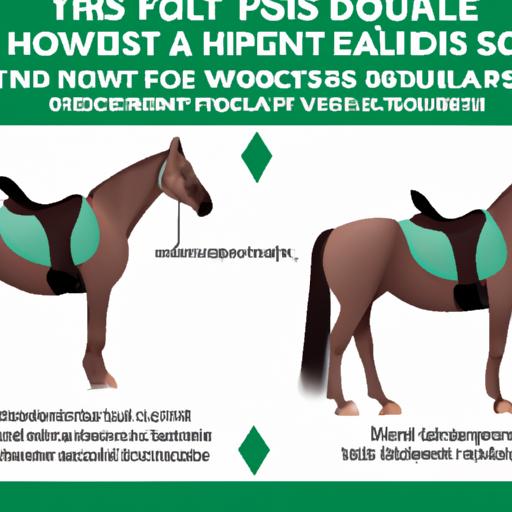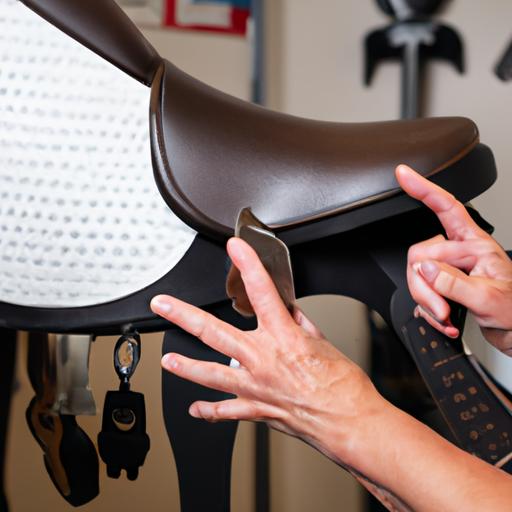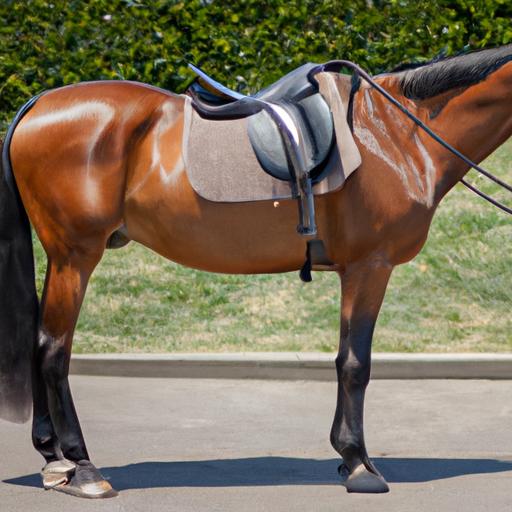Unlock Your Horse’s Potential: Explore the Connection between Saddle Fit and Horse Behavior. Discover the Impact of Incorrect Saddle Fit on Performance.
As equestrians, we understand the profound connection between horse behavior and performance. One crucial factor that can greatly influence both is the fit of the saddle. A well-fitted saddle is not just a luxury; it is an absolute necessity for the overall well-being and comfort of our equine partners. In this article, we will delve into the importance of saddle fit for horse behavior and explore the detrimental effects of an incorrectly fitting saddle on their performance.
When we talk about saddle fit, we are referring to the proper alignment and balance of the saddle on a horse’s back. A saddle that fits perfectly allows the horse to move freely, without any restrictions or discomfort. On the flip side, an ill-fitting saddle can cause a myriad of issues, both physical and psychological, which can significantly impact a horse’s behavior.
Imagine wearing a pair of shoes that are several sizes too small. The constant pressure and rubbing against your feet would undoubtedly alter your gait and mood. Horses experience a similar discomfort when subjected to an ill-fitting saddle. They may display behavioral changes such as pinning their ears, bucking, or even refusing to move forward. These are clear signs that the saddle is causing discomfort and negatively affecting their behavior.
A horse’s performance is directly linked to their behavior. If they are uncomfortable due to an incorrect saddle fit, their movements will be restricted, and they may struggle to perform at their best. This can lead to a decrease in agility, impeded collection, and even reluctance to engage in certain exercises. It is essential to understand that these behavioral changes are not due to any fault on the horse’s part; rather, they are a direct result of the discomfort caused by the saddle.
Next, we will delve deeper into the relationship between saddle fit and horse behavior, exploring how saddle fit affects their comfort and movement, as well as the psychological impact of an ill-fitting saddle. So, join me in the next section as we uncover the intricate connection between saddle fit and horse behavior.
Understanding Saddle Fit

A well-fitted saddle is like a tailored suit, specifically designed to provide optimal comfort and support for both horse and rider. To grasp the importance of saddle fit, let’s explore the anatomy of a saddle and its components, delve into the key considerations for evaluating saddle fit, and familiarize ourselves with the common signs of an incorrectly fitting saddle.
Anatomy of a Saddle and Its Components
Saddles are intricate pieces of equipment, consisting of various components that work together to ensure a secure and comfortable riding experience. Familiarizing ourselves with the saddle’s anatomy helps us understand how it interacts with the horse’s back. The main components include:
- Tree: The foundation of the saddle, usually made of wood or synthetic materials, provides the shape and structure.
- Seat: The part where the rider sits, designed to offer stability and balance.
- Gullet: The channel running along the length of the saddle’s underside, providing clearance for the horse’s spine.
- Panel: The cushioned area that rests against the horse’s back, distributing the rider’s weight evenly.
- Flaps: The leather coverings on the sides of the saddle, designed to protect the rider’s legs and provide stability.
- Stirrup Bars: Metal loops on the saddle’s underside, allowing the rider to attach the stirrups.
Evaluating Saddle Fit: Key Considerations
When assessing saddle fit, several factors come into play. It’s crucial to consider these key considerations to ensure the saddle fits the horse correctly:
- Clearance: The gullet should have ample clearance over the horse’s spine to prevent discomfort and pressure points.
- Balance: The saddle should sit evenly on the horse’s back, maintaining balance and symmetry.
- Contact: The panels should make uniform contact with the horse’s back without excessive pressure or gaps.
- Shoulder Freedom: The saddle should allow the horse’s shoulders to move freely, facilitating unrestricted movement.
- Twist: The twist of the saddle, the narrowest part of the seat, should suit the rider’s pelvic structure.
Common Signs of Incorrect Saddle Fit
Identifying the signs of an incorrectly fitting saddle is essential for addressing potential problems. Some common signs include:
- Soreness or white hairs: Pressure points can cause soreness or even lead to the development of white hairs, indicating long-term damage.
- Uneven sweat patterns: Excessive sweating or uneven sweat patterns beneath the saddle can indicate pressure points or improper weight distribution.
- Behavioral changes: Horses experiencing discomfort may exhibit behavioral changes such as resistance, refusal, or irritability.
Understanding the anatomy, evaluating saddle fit considerations, and recognizing common signs of an ill-fitting saddle are pivotal steps toward ensuring the optimal comfort and performance of both horse and rider. In the next section, we will explore the intricate relationship between saddle fit and horse behavior, shedding light on the effects of an incorrectly fitting saddle.
The Intricate Relationship between Saddle Fit and Horse Behavior

How Saddle Fit Affects Horse Comfort and Movement
Proper saddle fit plays a significant role in ensuring the comfort and freedom of movement for our equine companions. When a saddle fits correctly, it allows the horse’s muscles to work fluidly and their joints to move naturally. This unrestricted movement not only enhances their comfort but also enables them to perform to the best of their ability.
An ill-fitting saddle, however, can create discomfort and restrict a horse’s movement. It can lead to pressure points, pinching, or rubbing against sensitive areas, causing pain and irritation. As a result, horses may exhibit signs of discomfort, such as resistance, stiffness, or difficulty in performing certain movements. They may become reluctant to engage their hindquarters, struggle with transitions, or even display resistance when asked to perform lateral movements. All these behavioral changes are often a direct consequence of an incorrectly fitting saddle.
Behavioral Changes Due to Discomfort from Poor Saddle Fit
Horses are incredibly perceptive animals, and they have an innate ability to communicate their discomfort. When subjected to an ill-fitting saddle, they may display a range of behavioral changes as their way of expressing their discomfort. These changes can vary from subtle cues to more overt signs of distress.
Some horses may become irritable and exhibit behavioral issues such as tail-swishing, ear-pinning, or bucking. They may even show resistance when being saddled up or become reluctant to move forward. Others may show signs of anxiety, such as restlessness, pawing, or even attempting to bite or kick when the saddle is being adjusted.
It is crucial for riders and owners to pay attention to these behavioral changes and consider the possibility of an ill-fitting saddle. Addressing the saddle fit issue promptly can help alleviate these behavioral problems and restore the horse’s comfort and willingness to perform.
Psychological Impact of Incorrect Saddle Fit on Horses
The impact of an incorrectly fitting saddle goes beyond physical discomfort; it can also have psychological repercussions on our equine partners. Horses are sensitive animals that thrive on trust and a sense of security. When a saddle causes pain or discomfort, it can erode their trust in the rider and create a negative association with being ridden.
The psychological impact of an ill-fitting saddle can manifest in various ways. Horses may become anxious, tense, or even develop a fear response when saddled up. This can lead to a decrease in confidence, reluctance to engage in training or riding activities, and an overall deterioration in their emotional well-being.
Understanding the psychological impact of an incorrectly fitting saddle is crucial for creating a positive and harmonious partnership with our horses. By ensuring a proper saddle fit, we can not only improve their physical comfort but also nurture their trust and confidence, allowing them to thrive both mentally and emotionally.
In the next section, we will explore different methods for assessing saddle fit, including professional services and DIY evaluations. So, let’s dive into the practical aspects of saddle fit assessment and find the best approach for your horse’s well-being and behavior.
Assessing Saddle Fit

When it comes to ensuring the perfect saddle fit for your horse, there are multiple approaches you can take. In this section, we will explore two primary methods: seeking professional saddle fitting services or conducting a DIY saddle fit evaluation. Additionally, we will discuss the tools and techniques that can aid in assessing saddle fit accurately.
Professional Saddle Fitting Services: What to Expect
Opting for professional saddle fitting services can provide you with invaluable expertise and guidance. Saddle fitters are trained professionals who specialize in evaluating saddle fit and making necessary adjustments. They possess a deep understanding of equine anatomy, biomechanics, and saddle construction, allowing them to assess saddle fit comprehensively.
During a professional saddle fitting session, the fitter will examine your horse’s conformation, evaluate their movement, and assess the current saddle’s fit. They may use tools like flexible measuring tapes, pressure mapping systems, or even thermal imaging cameras to gather data. With their expertise, they can determine any areas of concern and recommend suitable saddle options or adjustments.
DIY Saddle Fit Evaluation: Step-by-Step Guide
If you prefer a more hands-on approach, conducting a DIY saddle fit evaluation can be an effective option. While it may not replace the expertise of a professional fitter, it allows you to regularly monitor the saddle fit between professional sessions.
To begin the evaluation, start by observing your horse’s behavior and movement both on the ground and under saddle. Look for signs of discomfort, such as resistance or changes in gait. Next, carefully examine the saddle while it is placed on your horse’s back. Ensure that the saddle sits evenly without any pressure points or excessive movement.
You can also perform a “finger test” by sliding your fingers between the saddle and your horse’s withers, shoulders, and back. If the saddle is too tight or loose in any of these areas, adjustments may be necessary. Additionally, pay attention to the balance and levelness of the saddle, ensuring it distributes the rider’s weight evenly.
Tools and Techniques for Assessing Saddle Fit
Several tools and techniques can assist you in assessing saddle fit accurately. A flexible measuring tape can help you measure your horse’s back length, width, and wither height, providing valuable information when selecting a saddle. Pressure mapping systems, such as saddle pads with built-in sensors, can offer insights into pressure distribution and potential pressure points.
Thermal imaging cameras can detect areas of increased heat, indicating potential inflammation or discomfort. Having these tools at your disposal can enhance your understanding of saddle fit and aid in making informed decisions.
In the next section, we will delve into addressing saddle fit issues, exploring methods to adjust an existing saddle for a better fit, and the importance of choosing the right saddle for your horse’s unique needs. So, let’s continue our journey towards optimal saddle fit and enhanced horse behavior.
Addressing Saddle Fit Issues
Ensuring a proper saddle fit is crucial for your horse’s well-being and behavior. If you suspect that your current saddle is causing discomfort, there are several steps you can take to address the fit issues and improve your horse’s experience.
Adjusting an Existing Saddle for Better Fit
If you have a saddle that you believe is close to the right fit but needs some adjustments, working with a professional saddle fitter can make a world of difference. These experts have the knowledge and experience to assess your saddle’s fit and make necessary modifications. They can adjust the saddle’s tree width, flocking, or panels to better conform to your horse’s back. By customizing the fit, they can alleviate pressure points and enhance your horse’s comfort and behavior.
Choosing the Right Saddle for Your Horse’s Unique Needs
Sometimes, adjusting an existing saddle may not be enough, especially if your horse has specific conformational challenges. In such cases, it may be beneficial to invest in a new saddle that is specifically designed to meet your horse’s needs. Consider factors such as your horse’s breed, conformation, and discipline when selecting a saddle. Working with a knowledgeable saddle fitter or equine professional can guide you in making an informed decision. Remember, a well-fitted saddle will not only improve your horse’s behavior but also enhance their performance and overall well-being.
Custom-Made Saddles: Pros and Cons
For horses with unique anatomy or those who require specialized support, custom-made saddles can be an excellent option. These saddles are tailored to fit your horse’s individual measurements, ensuring optimal comfort and performance. Custom saddles take into account factors such as wither shape, back length, and shoulder conformation. While they can be more expensive than off-the-shelf saddles, they offer a precise fit and can significantly improve your horse’s behavior and performance.
However, it’s important to note that custom saddles may take longer to be manufactured and delivered, so patience is key. Additionally, as your horse’s body changes over time, the custom saddle may require adjustments or reflocking to maintain an optimal fit. Regular communication with your saddle fitter or manufacturer is essential to address any fit issues that may arise.
In the next section, we will conclude our exploration of saddle fit and its impact on horse behavior. Stay tuned as we summarize the importance of regularly assessing saddle fit for your horse’s behavior and overall well-being.


